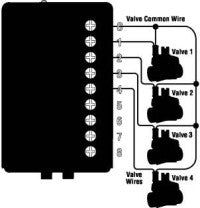A New Tool for Controlling Landscape and Pitch Irrigation
A New Tool for Controlling Landscape and Pitch Irrigation
By Tony Ware
Year on year, we are all used to electronics getting cheaper and giving more value. Just take mobile phones as an example. Remember the attaché case sized ones? They were the bee's-knees once! Now if the phone isn't so small one keeps losing it, doesn't take pictures, movies and play music, it has no 'street-cred'!
For some unaccountable reason these advances haven't found their way into the control of medium sized landscape and playing fields irrigation. Admittedly, the golf market has seen many advances in recent years, but all priced out of reach for those smaller areas. In this latter sector, the technology is 30 years old.
The old way is to have a controller with lots of terminals, each with a wire to leading to an individual solenoid on an electrically activated water valve. A 'common' wire completes the circuit, daisy-chaining to the other side of each solenoid, then back to the controller. This type of controller is called Multi-wire.

Although simple to understand, this method suffers from several significant disadvantages:
- New valves cannot be added without routing an extra wire for each, right back to the controller.
- Because of so many outputs, the lightning surge protection in many controllers tends to be a bit 'light-duty' to keep the costs down and the controller's size small.
- If the bundle of cables is damaged, it is a skilled and time-consuming job to join them all up again (and get it right!).
- The cost of the wire and the labour of its installation are significant.
The golf market has, for 2 decades, circumvented all these problems by embracing 'decoder' technology. This works by routing a single 2-wire cable around the whole area to be controlled. Everywhere there needs to be a valve, a 'decoder' is fitted between the cable and the valve. Each decoder is installed pre-numbered with a unique 'address' like a telephone extension number. Down the main 2-wire cable is sent power and impressed on this, a signal with the "extension number" of the valve to be turned on. All decoders hear these numbers, but only the matching one turns on its valve. (fig.2)

The advantages of decoders are:-
- New valves can be added by splicing a new cable spur into the existing 2 wire cable anywhere near and adding a new decoder with a different number.
- Lightning protection in decoders has become very robust indeed.
- Any breaks in the cable can be repaired without a degree in rocket science!
The major problem is cost. Typically the price of golf type controller and decoders is 5 to 10 times the cost of a multi-wire. For example the Hunter ICC multi-wire controller with 24 outputs lists at £324, while a popular golf controller and 24 decoders list at £2367; a ratio of over 7:1.
However, this is not the whole story. All valves must be connected to the controller somehow and this can be a very significant cost.
In the UK, a common cable type is multi-core telephone cable 'direct bury'. In the USA it is 18AWG insulated single core wire, one for each solenoid and of course the common wire.
The multi-core telephone cable is only made in a few bundle sizes, so there are usually spares, especially towards the end of the run. At each valve location, the outer sheath is ever so carefully slit, the common wire and the relevant solenoid wire identified, teased out of the gel-filled inner, cleaned, cut, stripped and spliced onto the solenoid wires. This is fiddly, time consuming and skilled work, thus representing a significant cost. For a 24 station system, this can add perhaps £1000. In contrast, the labour involved installing decoders is far simpler and is significantly cheaper, as is the 2-wire cable.
Thus the relative installed costs in the above example are more like: Multi-wire £1850, golf with decoders £2900; a ratio of 1.5:1
This ratio now improves significantly with the introduction of a decoder adapter for the Hunter ICC controller, the first in a range of adaptors to turn many makes of low cost multi-wire controllers into decoder systems. The adapted ICC, together with 24 decoders lists at £1162, half the cost of the example golf controller. This brings the cost ratio to around 1:1,
One can now enjoy all the benefits of decoder control for no extra installed cost over multi-wire.
Tony Ware B.Sc.
Tonick Watering Ltd
www.tonick.co.uk
